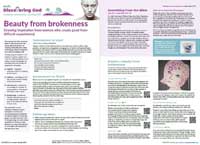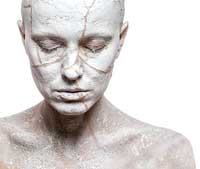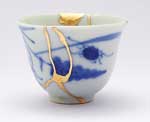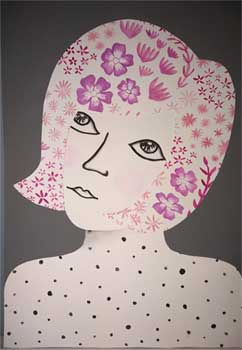Drawing inspiration from women who create good from difficult experiences

Click on the image to view a PDF.
Discovering God offers practical ideas for informal services and events where the focus is on creating community and a sense of belonging, demonstrating that the church is available to all.
Guidance on using Discovering God can be found at: www.rootsontheweb.com/dg-intro
Somewhere to start
Here’s a way to introduce the theme.
- Display a collection of items that are broken or discarded: e.g. cracked crockery, broken jewellery, misshapen fruit and vegetables, packaging, torn or stained clothing, dead flowers, found objects.
- Ask people to think of as many possible alternative uses for each type of item (you could do this in teams, with a prize for the longest list).
Sometimes life leaves us feeling broken or useless; how can we turn that around to create something good?
Mother God,
sometimes we feel lost, broken, discarded and useless.
We seek your loving arms to comfort us,
your strength to keep us going,
and your creativity to inspire us
to find beauty from brokenness.
Amen.
Somewhere to finish
Before you end, come together to gather your thoughts and, if appropriate, to pray.
- Listen to the song ‘Beauty for Ashes’ by Charity Quin.
- Give everyone a small leaf-shaped card and a pen.
- Invite people to think of a person who gives them hope, and to write their name on the leaf.
- On the other side, they could write (or draw) about something good they have experienced out of a difficult time in their life.
- Invite everyone to hang their leaf on the ‘Tree of Hope’ (see Banners of hope below), along with the mosaic mobiles (if you made them during the Beauty from brokenness activity - see below); then sit quietly and listen to the end of the song.
Follow-up ideas
- Make a mosaic decoration for a woman you know who is a bit of a ‘shero’ (she-hero) to you. Don’t forget to tell her why you think she’s so special.
- 8 March 2023 is International Women’s Day. Check out the resources on the website to see how you can get involved.
- Create a shero poster for your wall or cupboard door. Include images of women you admire, a favourite quote from them, a symbol relating to their field (e.g. sport, human rights, environment), and a list of their qualities.
Something from the Bible
Luke 8:1-3 and John 20:1-18
You might have heard different things about Mary Magdalene, but these are the main two stories in the Bible that we know are about her. The first is a brief mention of her among other followers of Jesus, but hints at her back story; in the second, she has a central role.
Read and share
Read the passage from John using a story version, such as in The Book of Books by Trevor Dennis. Ask people to listen, imagining that they are Mary. What are they (as Mary) thinking and feeling, as the story unfolds? Introduce the short ‘back story’ from Luke; Mary is someone who has been ‘healed of demons’.
We don’t know what Mary’s demons were; nowadays we might call it trauma. Ask people to think of examples of traumatic experiences that call for extreme healing. Then read the Luke passage:
- How do you imagine Mary feels about Jesus?
- Does that change our understanding of Mary in the other (John) story?
What can we learn from this passage?
People often think of Jesus’ disciples as exclusively male, from humble backgrounds; yet here is one of several wealthy women, part of the group of disciples travelling with Jesus and, we are told, supporting him financially. Mary is portrayed as an important female disciple, despite her troubled past. Contrary to what is sometimes said, there is nothing in the Gospels to suggest that Mary did anything wrong; just that she had suffered and been in need of healing. How does this fit with our idea of the disciples? And our image of leaders more generally?
The story of Jesus’ resurrection is arguably the most important event in Jesus' life. What does it say about the nature of Mary – and the role of women – that it was she who went to the tomb first, and she who witnesses Jesus, rather than one of the men?
 |
Kintsugi is the Japanese art of mending broken pottery with gold.
- What has helped you to get through difficult times?
- Where can you see strength or beauty that has come out of adversity you have lived through?
|
Explore...beauty from brokenness
Choose from these activities to help people explore the theme. Use the spiritual styles indicated by the coloured letters (see Spiritual styles key) to help you plan and cater for the different ways in which people connect with God.
Transformed lives E A
Watch the first 5.10 minutes of The Chosen: Mary Magdalene: Part II, ending with the line ‘…the Bible is God’s breath’. We often hear stories of men as strong, and women as caring. Do you think men and women deal with adversity differently? Can you think of other examples of women who have overcome adversity? What do you think helped them to be strong? The video clip says the teaching from Bible helped Mary. Is there a story or a verse that inspires you? How can we support each other through adversity?
Banners of hope W E S
You will need: strips of plain cotton fabric and art materials.
Shero tales W E
- Source some stories of real life sheroes who have come through adversity and inspired others (e.g. Malala Yousafzai, Mary Seacole, Greta Thunberg) and give these to volunteers.
- Invite others to question the sheroes (i.e. the volunteers in role) and try to guess who they are.
- Ask people to make a list of some of the qualities the sheroes share. Which of these qualities would they choose as their ‘superpower’ and why?
Beauty from brokenness E S
You will need: small lids (e.g. milk or juice bottle tops), tile adhesive, wire, broken jewellery/crockery, etc., thick cord.
Transform some of the broken things you used at the start of the session to make beautiful mosaic mobiles.
- Add a wire hanging loop to one edge of a jar lid. Fill it with tile adhesive, then decorate with broken tiles, crockery, beads, and found objects. Full instructions and pictures.
- Hang these on the ‘Tree of Hope’ (see Banners of hope).
Local sheroes W E A
- If you can, invite someone from a local project that helps women to speak about their work. If you don't know where to start, these national organisations may be able to point you in the right direction: Women’s Refuge, Refugee Action, The Girls’ Network).
- Alternatively, discuss ideas about local sheroes you could invite. What inspiration can you draw from their work? Plan a way you can support them, e.g. collecting care parcels.
Additional inspiration
Mosaic potholes
Spiritual styles (as defined by Dave Csinos) key: Word, Emotion, Symbol, Action. Find out more in Worship and learning support.